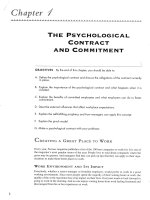Chapter 01 the psychological contract
Bạn đang xem bản rút gọn của tài liệu. Xem và tải ngay bản đầy đủ của tài liệu tại đây (308.39 KB, 26 trang )
Organizational Behavior: An
Experiential Approach 7/E
Joyce S. Osland, David A. Kolb,
and Irwin M. Rubin
1
©2001 by Prentice Hall,
Inc.
Chapter 1
Organizational Behavior: An
Experiential Approach 7/E
Joyce S. Osland, David A. Kolb,
and Irwin M. Rubin
2
©2001 by Prentice Hall,
Inc.
Objectives
•
Define and understand the importance of the
psychological contract
•
Explain the self-fulfilling prophecy
•
Describe the external influences that affect
workplace expectations
•
Explain the pinch model
•
Make a psychological contract with your professor
•
List the characteristics of the field of OB
Organizational Behavior: An
Experiential Approach 7/E
Joyce S. Osland, David A. Kolb,
and Irwin M. Rubin
3
©2001 by Prentice Hall,
Inc.
Characteristics of OB
•
Multidisciplinary Nature
•
Three Levels of Analysis: Individual, Group,
and Organizational
•
Acknowledgement of Environmental Forces
•
Grounded in the Scientific Method
•
Performance Orientation
•
Applied Orientation
•
Change Orientation
Organizational Behavior: An
Experiential Approach 7/E
Joyce S. Osland, David A. Kolb,
and Irwin M. Rubin
4
©2001 by Prentice Hall,
Inc.
Mental Maps
Our images,
assumptions, and
stories about every
aspect of the world
that determine what
we see and how we
act.
Organizational Behavior: An
Experiential Approach 7/E
Joyce S. Osland, David A. Kolb,
and Irwin M. Rubin
5
©2001 by Prentice Hall,
Inc.
PSYCHOLOGICAL
CONTRACT
An individual’s beliefs,
shaped by the
organization, regarding
the terms and conditions
of a reciprocal exchange
agreement between
individuals and their
organization.
Organizational Behavior: An
Experiential Approach 7/E
Joyce S. Osland, David A. Kolb,
and Irwin M. Rubin
6
©2001 by Prentice Hall,
Inc.
Environmental Changes Impacting
Psychological Contracts
•
Technological change
•
Rate of change in the
business environment
•
Global economy
•
Changing economic
conditions
•
Uncertainty for workers
•
Demands for
performance, flexibility
and innovation
•
Reengineering
•
Downsizing
•
Mergers and
acquisitions
•
Outsourcing and
subcontracting of work
•
Contingent and
temporary employment
for peripheral
employees
Organizational Behavior: An
Experiential Approach 7/E
Joyce S. Osland, David A. Kolb,
and Irwin M. Rubin
7
©2001 by Prentice Hall,
Inc.
Environmental Changes
Impacting Psychological
Contracts
•
Fewer full-time jobs
and core employees
•
Relatively low union
representation
•
Less job security
Organizational Behavior: An
Experiential Approach 7/E
Joyce S. Osland, David A. Kolb,
and Irwin M. Rubin
8
©2001 by Prentice Hall,
Inc.
Workforce Changes Impacting
Psychological Contracts
Demographics
Switch from high- to low-unemployment
Nomadic nature of the workforce
Changing complexion of the workforce
Changing value trends
Organizational Behavior: An
Experiential Approach 7/E
Joyce S. Osland, David A. Kolb,
and Irwin M. Rubin
9
©2001 by Prentice Hall,
Inc.
A Nomadic Work Force
-13 different jobs for the average
high school or college graduate
–
3.5 years on each job
Organizational Behavior: An
Experiential Approach 7/E
Joyce S. Osland, David A. Kolb,
and Irwin M. Rubin
10
©2001 by Prentice Hall,
Inc.
Projected Year 2020
Workforce
•
50% Women
•
68% White non-Hispanics
•
14% Hispanics
•
11% African Americans
•
6% Asians
Organizational Behavior: An
Experiential Approach 7/E
Joyce S. Osland, David A. Kolb,
and Irwin M. Rubin
11
©2001 by Prentice Hall,
Inc.
Self-Fulfilling Prophecy
People perform in
accordance with
a rater’s
expectations of
them
Organizational Behavior: An
Experiential Approach 7/E
Joyce S. Osland, David A. Kolb,
and Irwin M. Rubin
12
©2001 by Prentice Hall,
Inc.
Model for Managing
Psychological Contracts
Organizational Behavior: An
Experiential Approach 7/E
Joyce S. Osland, David A. Kolb,
and Irwin M. Rubin
13
©2001 by Prentice Hall,
Inc.
Broken Contracts
•
Outrage, shock, resentment,
anger
•
Decreased trust and good faith
•
Decreased job satisfaction
•
Decreased productivity
•
Decreased attendance
•
Turnover
Cause
Organizational Behavior: An
Experiential Approach 7/E
Joyce S. Osland, David A. Kolb,
and Irwin M. Rubin
14
©2001 by Prentice Hall,
Inc.
Contract Makers’ Violations
Sources Violations
Recruiters
•
Unfamiliar with actual job
•
Overpromise
Managers
•
Say one thing, do another
Co-workers
•
Failure to provide support
Mentors
•
Little follow-through
•
Few interactions
Top management
•
Mixed messages
Organizational Behavior: An
Experiential Approach 7/E
Joyce S. Osland, David A. Kolb,
and Irwin M. Rubin
15
©2001 by Prentice Hall,
Inc.
Sources Violations
Compensation
•
Changing criteria
•
Reward seniority, low job security
Benefits
•
Changing coverage
Career paths
•
Dependent on one’s manager
•
Inconsistent application
Performance review
•
Not done on time
Training
•
Skills learned not tied to job
Documentation
•
Stated procedures at odds with actual
practice
Systems Contract Violations
Organizational Behavior: An
Experiential Approach 7/E
Joyce S. Osland, David A. Kolb,
and Irwin M. Rubin
16
©2001 by Prentice Hall,
Inc.
Sources of Experienced
Violation
Inadvertent
Able and willing
(divergent interpretations
made in good faith)
Willing but unable
(inability to fulfill contract)
Disruption
Able but unwilling
(reneging)
Breach of contract
Organizational Behavior: An
Experiential Approach 7/E
Joyce S. Osland, David A. Kolb,
and Irwin M. Rubin
17
©2001 by Prentice Hall,
Inc.
RESPONSES TO VIOLATION
Constructive Destructive
Active Voice Neglect/Destruction
Passive Loyalty/Silence Exit
Organizational Behavior: An
Experiential Approach 7/E
Joyce S. Osland, David A. Kolb,
and Irwin M. Rubin
18
©2001 by Prentice Hall,
Inc.
Why Generations Differ
•
Each generation is a product of
historical events that shape their values
and views of the world
•
Emotional memories shape feelings
about institutions, authority, materialism,
family and careers
Organizational Behavior: An
Experiential Approach 7/E
Joyce S. Osland, David A. Kolb,
and Irwin M. Rubin
19
©2001 by Prentice Hall,
Inc.
How to Manage Gen X’ers
•
Vary their assignments
•
Teach them new skills
•
Teach them some manners
•
Keep them in the loop
•
Tie praise for a job well done to a concrete
reward
•
Keep it fun
Organizational Behavior: An
Experiential Approach 7/E
Joyce S. Osland, David A. Kolb,
and Irwin M. Rubin
20
©2001 by Prentice Hall,
Inc.
Advantages of Committed
Employees
Have the self-control required for teamwork,
empowerment, and flatter organizations
Display organizational citizenship behavior that
benefits the organization
Are “willing to help”
Organizational Behavior: An
Experiential Approach 7/E
Joyce S. Osland, David A. Kolb,
and Irwin M. Rubin
21
©2001 by Prentice Hall,
Inc.
Advantages of Committed
Employees
Have better attendance records
Stay with the company longer
Work harder at their jobs
Adapt better to unforeseeable occurrences
Perform better
Organizational Behavior: An
Experiential Approach 7/E
Joyce S. Osland, David A. Kolb,
and Irwin M. Rubin
22
©2001 by Prentice Hall,
Inc.
Earning Employee
Commitment
Commit to people-first values:
Put it in writing
Hire right-kind managers
Walk the talk
Organizational Behavior: An
Experiential Approach 7/E
Joyce S. Osland, David A. Kolb,
and Irwin M. Rubin
23
©2001 by Prentice Hall,
Inc.
Earning Employee
Commitment
Clarify and communicate your mission:
Clarify the mission and ideology
Make it charismatic
Use value-based hiring practices
Stress values-based orientation and training
Build the tradition
Organizational Behavior: An
Experiential Approach 7/E
Joyce S. Osland, David A. Kolb,
and Irwin M. Rubin
24
©2001 by Prentice Hall,
Inc.
Earning Employee
Commitment
Guarantee organizational justice:
Have a comprehensive grievance procedure
Provide for extensive two-way communications
Organizational Behavior: An
Experiential Approach 7/E
Joyce S. Osland, David A. Kolb,
and Irwin M. Rubin
25
©2001 by Prentice Hall,
Inc.
Earning Employee
Commitment
Create a sense of community:
Build value-based homogeneity
Share and share alike
Emphasize barn-raising, cross-utilization,
and teamwork
Get together









